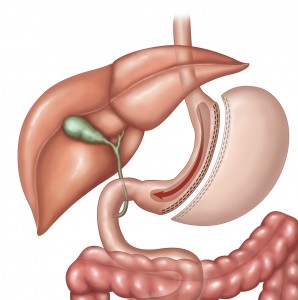What is Laparoscopic Sleeve Gastrectomy?
This is a weight loss surgery that is usually performed minimally-invasively using a laparoscope. This procedure is a purely restrictive operation and does not involve any bypassing of the intestines or gastrointestinal malabsorption. The newest of the weight loss surgeries, it is growing in popularity. Surgical criteria now match the criteria for other weight loss surgeries.
Why did Jarrett Thomas choose Sleeve Gastrectomy?
Like others, Jarrett Thomas made a big decision to have surgery to overcome the barriers that kept him from losing weight, threatening his health and life. But then he had to make another decision – which kind of weight loss surgery. Watch this video to learn more about Jarrett, his decision and the outcome.
How is the surgery performed?
The surgeon removes a large portion of the stomach so that approximately 20 to 25 percent of the stomach remains in the shape of a tube or sleeve. It helps to understand this change by imagining that the new, smaller stomach is about the size of a banana. This limits the amount of food patients can eat by making them feel full after eating smaller amounts of food. Laparoscopic Sleeve Gastrectomy is often commonly referred to as the Gastric Sleeve.

The surgery is performed laparoscopically in an operating room at North Florida Regional Medical Center by one of our bariatric surgeons. The surgeon makes a few, small cuts in a patient’s abdomen. The surgeon will pass the laparoscope and the instruments needed to perform the surgery through these openings, including a tiny camera. The camera is connected to a video monitor in the operating room. The surgeon will look at the monitor to see inside a patient’s abdomen during the procedure. Thin surgical instruments are also inserted through the small surgical incisions. The surgeon removes 75 to 85 percent of a patient’s stomach and joins the remaining portions of the stomach together using surgical staples. The surgery does not involve cutting or changing the sphincter muscles that allow food to enter or leave the stomach.
Because the sleeve gastrectomy is performed laparoscopically, patients can expect a shorter hospital stay, faster recovery, smaller scars and less pain compared to open surgical procedures.
What can I expect after surgery?
Following surgery, patients will be on a clear, liquid diet for one week. Patients will then progress to a full liquid diet before progressing to a diet composed of pureed foods low in fat and sugar. Patients are educated prior to surgery on their dietary and nutritional needs. Our staff carefully shares the diet progression with patients to be sure the plan is understood. It is critical that this diet progression is followed to prevent pain or serious complications. Patients usually return to normal activities within 4 to 6 weeks.
Sleeve gastrectomy patients can expect fewer follow-up visits compared to lap-band patients, but some appointments are necessary, and attending those follow-up visits is mandatory for our program. The first post-op visit to the clinic office will be scheduled 7 to 10 days after surgery. Patients can also expect a follow-up visit 6 weeks after surgery. At this point, the follow-up visits stretch out more. Patients return at 3, 6, 9, 12 months and then yearly after surgery for follow-up visits.
Sleeve gastrectomy is the newest of the weight loss surgery options and is growing in popularity as an option that allows faster weight loss than adjustable gastric banding with fewer risks of complications that are sometimes seen with gastric bypass.
Unlike adjustable gastric banding, sleeve gastrectomy is irreversible. All weight loss surgeries have benefits and disadvantages. We recommend patients take the time to gather information, talk with their physician and then make the decision about which weight loss surgery will best help them lose weight and regain their health.